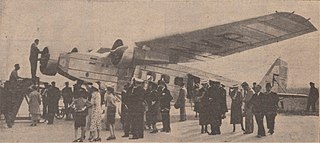
The ANF Les Mureaux 110 and its derivatives were a family of French reconnaissance aircraft developed in the 1930s. They were all-metal, parasol-wing monoplanes that seated the pilot and observer in tandem open cockpits. The aircraft were widely used in the Battle of France, but were all scrapped soon thereafter.

The Morane-Saulnier M.S.225 was a French fighter aircraft of the 1930s. It was produced in limited quantities to be used as a transitional aircraft between the last of the biplanes and the first monoplane fighters.

The Bloch MB.120 was a French three-engine colonial transport aircraft built by Société des Avions Marcel Bloch during the 1930s.

The CAMS 30E was a two-seat flying boat trainer built in France in the early 1920s. It was the first aircraft designed for CAMS by Raffaele Conflenti after he had been recruited by the company from his previous job at Società Idrovolanti Alta Italia (SIAI). It was a conventional design for the era featuring a two-bay equal-span unstaggered biplane wing cellule. The prototype was exhibited at the 1922 Salon de l'Aéronautique and evaluated the following year by the Aéronautique Maritime. The type's favourable performance led to an order of 22 machines for the French military and an export order of seven for Yugoslavia and four for Poland.

The CAMS 37 was a flying boat built in France in the mid-1920s that was originally designed for military reconnaissance, but which found use in a wide variety of roles in a large number of versions. It was the first design for Chantiers Aéro-Maritimes de la Seine (CAMS) by the company's new head designer, Maurice Hurel. The prototype was displayed at the 1926 Salon de l'Aéronautique in Paris. The prototype first flew in 1926, and after testing was ordered into service before the end of the year. It was a conventional biplane flying boat very similar to previous CAMS designs, being driven by a pusher propeller whose engine was mounted on struts in the interplane gap. The first production version was the amphibious CAMS 37A that was bought by the French Navy, the Portuguese Navy and the aeroclub of Martinique.

The CAMS 55 was a reconnaissance flying boat built in France in the late 1920s which equipped the French Navy throughout the 1930s.

The Potez 540 was a French multi-role aircraft of the 1930s. Designed and built by Potez, it served with the French Air Force as a reconnaissance bomber, also serving with the Spanish Republican Air Force during the Spanish Civil War. Although obsolete as a bomber, it remained in service in support roles and in France's overseas colonies at the start of World War II.

The Loire 46 was a French single-seater fighter aircraft of the 1930s. A high-winged monoplane designed and built by Loire Aviation, it was purchased by the French Air Force. It was also supplied to the Spanish Republican forces during the Spanish Civil War, but was almost out of service by the outbreak of World War II.

The Dewoitine D.1 was a French single-seat fighter aircraft of the 1920s, built by the French industrial company Dewoitine.

The Chyetverikov MDR-6 was a 1930s Soviet Union reconnaissance flying-boat aircraft, and the only successful aircraft designed by the design bureau led by Igor Chyetverikov.

The Stinson Voyager was a 1940s American light utility monoplane built by the Stinson Aircraft Company.

The Caudron C.440 Goéland ("seagull") was a six-seat twin-engine utility aircraft developed in France in the mid-1930s.
The Donnet-Denhaut flying boat was a maritime patrol and anti-submarine warfare aircraft produced in France during the First World War. Known at the time simply as "Donnet-Denhaut" or "DD" flying boats, the DD-2, DD-8, DD-9, and DD-10 designations were applied retrospectively to denote the various changes in configuration made during their service life.

The Rohrbach Ro X Romar was a German long-range commercial flying-boat and the last aircraft designed and built by Rohrbach Metall Flugzeugbau GmbH.

The Wibault 7 was a 1920s French monoplane fighter designed and built by Société des Avions Michel Wibault. Variants were operated by the French and Polish military and built under licence for Chile as the Vickers Wibault.

The SPL was a submarine borne flying boat designed and built in the USSR from 1931.

The Starck AS-70 Jac is a French-built single-seat light aircraft of the mid-1940s.

The Loening SL was an American submarine-based reconnaissance flying boat designed and built by Loening Aeronautical Engineering for the United States Navy.

The Bréguet 410 was a French bomber of the early 1930s. Not many of these twin-engined sesquiwing biplanes were built. At least one Breguet 413, one of its variants, was sold to the Spanish Republican Air Force during the Spanish Civil War.
The Grigorovich M-19 was a reconnaissance flying boat designed by Grigorovich in the late 1910s. The M-19 was a Grigorovich M-9 modified to be of the same size as the Grigorovich M-15. Assembly of the prototype was started in 1918, but the aircraft was not completed.



















